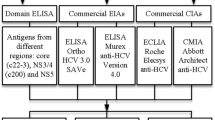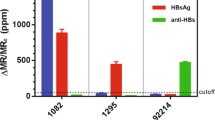Abstract
Introduction: As a contagious disease caused by hepatitis C virus (HCV) hepatitis C is a serious threat to human health. Therefore, the detection and verification of HCV infection is very important in the treatment of hepatitis C. This study investigated the preparation, quality control, and clinical evaluation of a protein chip capable of simultaneously detecting different HCV antibodies. The aim was to establish a convenient method for the detection of HCV.
Method: To prepare the protein chip, six antigens including five recombinant HCV antigens (chimeric, core, NS3, NS4, and NS5) and interleukin (IL)-l were arrayed onto aldehyde-coated slides and blocked using 10% calf serum in phosphate buffered saline. After dilution with sample solution, the serum sample was added to a reaction well on the protein chip. After incubation for 30 minutes at 37°C, fluorescence Cy3-labeled rabbit antihuman IgG was added and incubated again for 30 minutes at 37°C, and then scanned. Positive or negative controls were established from serum samples with or without HCV infection. Clinical evaluation was done by detecting 490 serum samples using the protein chips and ELISA reagents, with 150 of the 490 serum samples confirmed by recombinant immunoblot assay (RIBA).
Results: The protein chip for detection of five HCV antibodies was successfully prepared. Fifteen positive controls and 15 negative controls were established as standard samples for quality control. The quality control-passed protein chip was tested again using the standard of the National Institute for the Control of Pharmaceutical and Biological Products (NICPBP), and met the quality control criteria prescribed by the NICPBP. In the clinical evaluation with 490 samples, the coincidence rates between the protein-chip assay and ELISA were 97.4% for positive and 100% for negative results. Five inconsistent samples that were positive in ELISA, but non-positive (four samples) or negative (one) in the protein-chip assay, were confirmed by RIBA (gold standard) to be four non-positive and one negative. The results of 150 samples showed the coincidence rates between protein chip and RIBA were 98.15% for positive and 96.88% for single-segment positive.
Conclusion: The protein-chip assay has higher sensitivity and specificity than ELISA and has a high coincidence rate with RIBA. The protein chip, characterized by its easy operation and low economic cost, will be very useful for in vitro detection of HCV antibodies.








Similar content being viewed by others
References
Dienstag JL. Sexual and perinatal transmission of hepatitis C. 1997; 26 Suppl. 1: 66S–70S
Liu XG. Laboratory diagnostics of viral hepatitis. 2nd ed. Beijing: People’s Medical Publishing House, 1999: 450–75
Hao F, Yu ZY. Basis and clinic of hepatitis virus C. Beijing: People’s Medical Publishing House, 1999: 241–69
Zhu H, Snyder M. Protein arrays and microarrays. Curr Opin Chem Biol 2001; 5: 40–5
Ross-Macdonald P, Coelho PS, Roemer T, et al. Large-scale analysis of the yeast genome by transposon tagging and gene disruption. Nature 1999; 402: 413–8
Martzen MR, McCraith SM, Spinelli SL, et al. A biochemical genomics approach for identifying genes by the activity of their products. Science 1999; 286: 1153–5
Bussow K, Cahill D, Nietfeld W, et al. A method for global protein expression and antibody screening on high-density filters of an arrayed cDNA library. Nucleic Acids Res 1998; 26: 5007–8
Huang RP, Huang R, Fan Y, et al. Simultaneous detection of multiple cytokines from conditioned media and patient’s sera by an antibody-based protein array system. Anal Biochem 2001; 294: 55–62
Joos TO, Schrenk M, Hopfl P, et al. A microarray enzyme-linked immunosorbent assay for autoimmune diagnostics. Electrophoresis 2000; 21: 2641–50
Wiltshire S, O’Malley S, Lambert J, et al. Detection of multiple allergen-specific IgEs on microarrays by immunoassay with rolling circle amplification. Clin Chem 2000; 46(12): 1990–3
Yoshioka M, Mukai Y, Matsui T, et al. Immobilization of ultra-thin layer of monoclonal antibody on glass surface. J Chromatogr 1991; 566: 361–8
Acknowledgements
This work was supported by a grant from the National Natural Sciences Foundation of China for Key Program (39889001). We are indebted to the First Affiliated Hospital of Zhejiang University, Hangzhou Municipal Infectious Diseases Hospital, and the No.302 Hospital of PLA for supplying clinical samples.
The authors have no conflicts of interest relevant to the contents of this manuscript.
Author information
Authors and Affiliations
Corresponding author
Rights and permissions
About this article
Cite this article
Zhang, W., Huang, J., Zhou, MF. et al. Protein Chip for Detection of Different HCV Antibodies. CNS Drugs 9, 81–87 (2005). https://doi.org/10.1007/BF03260075
Published:
Issue Date:
DOI: https://doi.org/10.1007/BF03260075




